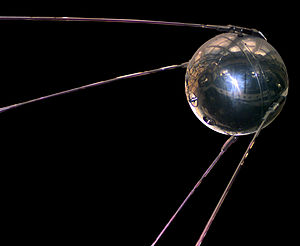56th Anniversary of Sputnik Launch Today
By Space Coast Daily // October 4, 2013
Sputnik 1 project dates back to Dec. 17, 1954
ABOVE VIDEO: The Launch of Sputnik was recorded as Oct.4, 1957. Sputnik launched during the International Geophysical Year, at the 5th Tyuratam range, in Kazakh SSR, now at the Baikonur Cosmodrome. The satellite travelled at 18,000 mph, taking 96.2 minutes to complete an orbit, and emitted radio signals at 20.005 and 40.002 MHz which were monitored by amateur radio operators throughout the world. The signals continued for 22 days until the transmitter batteries ran out on Oct.26, 1957. Sputnik then burned up on Jan. 4, 1958, as it fell from orbit upon reentering Earth’s atmosphere, after travelling about 37 million miles and spending 3 months in orbit.
BREVARD COUNTY, FLORIDA — The history of the Sputnik 1 project dates back to Dec. 17, 1954, when Sergei Korolev addressed Dimitri Ustinov, the Minister of Defence Industries, proposing the development of an Earth-orbiting satellite.

Tikhonravov emphasized that an artificial satellite is an inevitable stage in the development of rocket equipment in 1951, after which “interplanetary communication” would become possible.
On July 29, 1955 the President Dwight D. Eisenhower announced, that the United States would launch an artificial satellite during the International Geophysical Year (IGY).
A week later, on Aug. 8 the Presidium of the Central Committee of the CPSU approved the idea of creating an artificial satellite.
On Aug. 30 Vasily Ryabikov – the head of the State Commission on R-7 rocket test launches – held a meeting where Korolev presented calculation data for a spaceflight trajectory to the Moon.
They decided to develop a three-stage version of the R-7 rocket for satellite launches.
For more information visit Wikipedia.org











